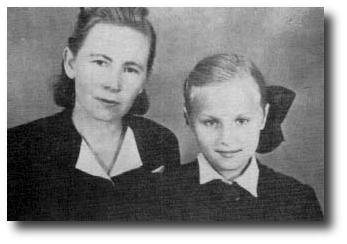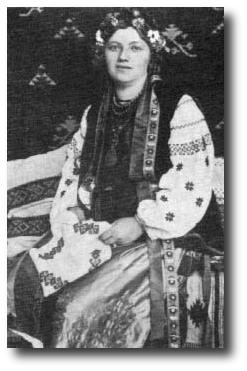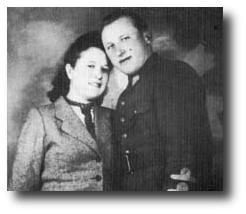![[LITOPYS UPA: Chronicle of the Ukrainian Insurgent Army]](/upa/images/litopys.jpg)
SERIES 1
VOLUME 5
![[LITOPYS UPA: Chronicle of the Ukrainian Insurgent Army]](/upa/images/litopys.jpg)

 We have undertaken to publish in Litopys UPA documents and other
materials relating to the history of the UPA. As we all know, outside
of Ukraine there is not much documentation of UPA combat. On many
topics relating to the UP,I, including its activities in various
regions of Ukraine, very little or no information exists. The gaps in
information can be filled to some extent by the memoirs of people now
living in the West who were participants or eye-witnesses of major
events of the time. For example, in the underground materials that
have survived there are only a few allusions to friendly relations
between the UPA and Hungarian army in Ukraine, but there are armed
reports of clashes. It turns out, however, that a secret
non-aggression pact had been made with the Hungarian army in Volyn'
and later, the Hungarian forces in the Carpathians. One participant of
the negotiation that led to that agreement was Captain Andriy
Dolnyts'ky, who made his way to the West. We are sad to report that he
died on July 6, 1982. He wrote a memoir describing the contacts that
took place between the UPA and the Hungarian army in Volyn' in
1943. Dolnyts'ky's memoir may be the sole source of information on
this matter; it is not known whether any Ukrainian or Hungarian
documents pertaining to that agreement have survived, whether any
other participants of the negotiation have been able to write about
them in such a detailed way. The other memoirs in this volume serve to
fill similar information gaps.
We have undertaken to publish in Litopys UPA documents and other
materials relating to the history of the UPA. As we all know, outside
of Ukraine there is not much documentation of UPA combat. On many
topics relating to the UP,I, including its activities in various
regions of Ukraine, very little or no information exists. The gaps in
information can be filled to some extent by the memoirs of people now
living in the West who were participants or eye-witnesses of major
events of the time. For example, in the underground materials that
have survived there are only a few allusions to friendly relations
between the UPA and Hungarian army in Ukraine, but there are armed
reports of clashes. It turns out, however, that a secret
non-aggression pact had been made with the Hungarian army in Volyn'
and later, the Hungarian forces in the Carpathians. One participant of
the negotiation that led to that agreement was Captain Andriy
Dolnyts'ky, who made his way to the West. We are sad to report that he
died on July 6, 1982. He wrote a memoir describing the contacts that
took place between the UPA and the Hungarian army in Volyn' in
1943. Dolnyts'ky's memoir may be the sole source of information on
this matter; it is not known whether any Ukrainian or Hungarian
documents pertaining to that agreement have survived, whether any
other participants of the negotiation have been able to write about
them in such a detailed way. The other memoirs in this volume serve to
fill similar information gaps.
With the exception of one underground document, all the materials included in this volume of Litopys UPA are memoirs of participants or observers of the UPA struggle in Volyn' and Polissia. The underground document is an article entitled "North-Western Ukraine-the Armed Self-defense of the Ukrainian People". This is perhaps the earliest detailed account of the UPA struggle in Volyn' and Polissia. It was written at the end of May or beginning of June, 1943, and appeared in the eleventh issue of the Visnyk of the Ukrainian Information Service, which was published sometime in June, 1943. The article has survived in the form of a typewritten manuscript; no original copy of that issue of the Visnyk has been located in the West. The article was written by Volodymyr Makar for the editors of the Visnyk. It is a compilation of reports from the UPA Command and the OUN Leadership in Volyn'. This compilation is an important document not only because it describes the course of the UPA struggle to about the middle of May, 1943, but because it tells us how the UPA Command assessed the prevailing situation and what strategies and tactics it intended to use in the future. Thus we have an analysis of Soviet partisan activity in Polissia, a discussion of the plan to expand the insurgent activities in Eastern Ukraine and an assessment of the successes of the insurgent movement and the difficulties it was encountering. Apart from this report, all the materials published here are recently-written memoirs. Most are by former UPA soldiers or members of the resistance; two are by persons who took direct part in the active struggle.
 The memoir by Andriy Dolnyls'ky mentioned above is a detailed account
of the UPA's discussions with the Hungarian army. It covers the whole
course of events from the initial contact between the two sides in the
village of Koniushky, near Zdolbuniv, in the summer of 1943, to the
author's departure with the Hungarian army headquarters to Lviv early
in 1944. The author was Chief of Intelligence at the UPA Southern
(Kremianets) Military Region headquarters, which was under the command
of Petro Oliinyk ("Enei"). At first Dolnyts'ky took part in the
discussions as a representative of his own military region; later he
was appointed member of a delegation representing the Supreme Command
of the UPA. He was assigned to accompany Lt. Col. Marton, Chief of the
Military Mission of the Hungarian Supreme Command to UPA and later was
a liaison officer with the Hungarian army headquarters. In addition to
the discussions with the Hungarians, Dolnyts'ky's account documents
various UPA activities and speaks about the organization of the UPA's
support network.
The memoir by Andriy Dolnyls'ky mentioned above is a detailed account
of the UPA's discussions with the Hungarian army. It covers the whole
course of events from the initial contact between the two sides in the
village of Koniushky, near Zdolbuniv, in the summer of 1943, to the
author's departure with the Hungarian army headquarters to Lviv early
in 1944. The author was Chief of Intelligence at the UPA Southern
(Kremianets) Military Region headquarters, which was under the command
of Petro Oliinyk ("Enei"). At first Dolnyts'ky took part in the
discussions as a representative of his own military region; later he
was appointed member of a delegation representing the Supreme Command
of the UPA. He was assigned to accompany Lt. Col. Marton, Chief of the
Military Mission of the Hungarian Supreme Command to UPA and later was
a liaison officer with the Hungarian army headquarters. In addition to
the discussions with the Hungarians, Dolnyts'ky's account documents
various UPA activities and speaks about the organization of the UPA's
support network.
V. Hrabenko was an instructor in the school for non-commissioned officers at the UPA Command headquarters in the Kostopil' region. Later he was company commander in the Kostopil' battalion, which was led by "Ostryi". Most of the time his company operated independently in the region of Kostopil' and Rivne. Hrabenko begins his story with a description of the school for non-commissioned officers and other centres operated by battalion command. He speaks of his meetings with various UPA officers, in particular, Col. Leonid Stupnyts'kyi ("Honcharenko"). Later he writes about his company's organization and training, the raids and battles it carried out and its contacts with other UPA detachments. In the late fall the author was wounded. While undergoing treatment, he was taken prisoner by the Germans. Early in the spring, while being transported to Germany through the Liubachiv county in Halychyna, he escaped.
The memoir written by V. Novak ("Krylatyi") is in a similar vein. Novak was a political officer, company commander and finally liaison officer in the UPA North Western Military Region "Turiv" in Volyn' oblast. He begins his report with a description of the Economic battalion in Luts'k (which was under German command). In the early spring of 1943 this battalion crossed over to the UPA. It operated in the Luts'k region, with Stepan Koval' ("Rubashenko") at its head. In the summer the author was transferred to the Kovel' UPA battalion, which was under command of "Holobenko." The memoir speaks of the activities of these battalions, their officers and their battles with the Germans and Soviet partisans. Later it describes how the author's detachment built a forest camp to house the military region's headquarters. We are also told of the author's participation in a three week officers' training course in 1943 and the assignments he was given. In addition the memoir contains valuable information about the organization of UPA detachments in the North-Western Military Region "Turiv."
Stepan Novyts'kyi's memoir centres on events that took place in the Volodymyr Volyns'kyi region. The author belonged to a group of UPA armourers, who were led by the commander "Yurko." The armourers collected weapons in the villages, repaired them and passed them on to the UPA. At first the armourers were part of the battalion led by "Slavko," then they moved to the "Sich" centre in the Svynars'k forest; finally, the vent to Dominopil', north of Volodymyr Volyus'kyi. In the spring of 1944 the armourers' group was disbanded and the author was named platoon leader in the so-called "territorial" company of the UPA, which was being organized in the Poryts'k district. The company soon found itself in the frontal zone. In mid-July the Germans captured the author. He was taken to Germany just a few days before the front moved to the Vistula River. Novyts'kyi's story describes not only the activities of the author's own detachment, but various events that took place at the time and people the author met. It mentions several battles in which the author took part, in particular the battle between "Slavko's" battalion and the Germans in the Zavydivs'k forest and the battle between the UPA and a detachment of Soviet partisans led by P. Vershyhora. Similar to Novyts'kyi's memoir is the short account by Vasyl Zahrava about the Korets' district in the region of Rivne. In his capacity as a courier, Zahrava had a lot of information about UPA activities in his district. He took part in the UPA attack on the outpost in the village of Holovnytsi. In the summer of 1944 he was arrested by NKVD. He ended up in the so-called "penal" battalion of the Red Army. The first time he saw battle action he was captured by the Germans.
Sophia Stepaniuk describes her experiences in German prisons in the Volyn' town of Kremianets' and Rivne. She was put into prison with her two-year-old daughter, Hanusia, at the time of the massive arrests of Ukrainian intellectuals in Volyn'. The Germans freed Hanusia, but they took the author to the prison in Rivne. She was tried and sentenced to the concentration camp at Auschwitz. The author tells us about her fellow women prisoners, many of whom were tortured and executed. Among them was Kharytia Kononenko, a prominent Ukrainian community activist. Before being taken to the concentration camp, the author managed to escape. Another women, Varvara Nykolaiuk, writes of her experiences in the Volodymyr Volyns'kyi region. The author's husband was in the UPA. She was pregnant at the time and had a small child. She often found herself in dangerous situations. Her story includes descriptions of events that took place in the Volodymyr Volyns'kyi region.
 Stepan Soroka writes of the organization of the Pidhaitsi UPA
company and its transfer to Volyn' in the fall of 1943. He speaks
about the members of the company, its armaments and equipment and the
operations it carried out. In Volyn' the author was assigned to the
company commanded by "Buria," which was operating in the Zdolbuniv
district. As a member of that company he went through military
training and took part in various operations. After Christmas he left
for home, where he was to join a local UPA detachment.
Stepan Soroka writes of the organization of the Pidhaitsi UPA
company and its transfer to Volyn' in the fall of 1943. He speaks
about the members of the company, its armaments and equipment and the
operations it carried out. In Volyn' the author was assigned to the
company commanded by "Buria," which was operating in the Zdolbuniv
district. As a member of that company he went through military
training and took part in various operations. After Christmas he left
for home, where he was to join a local UPA detachment.
The memoir by Mykhailo Lebid is rather different. At the time of the German occupation, the author served as chief of the Matiyiv district administration in the Kovel' region. His memoir describes many events that took place in his district. In particular it speaks of relations between the Ukrainian administration and its German overseers and tells us how the Germans' draconian laws were put into effect. It also mentions the mass extermination of Jews and prisoners-of-war from the Red Army, executions of Ukrainians and various events that took place at the time of the UPA struggle.
In general, these accounts provide us with new information; they speak of subjects about which nothing, or very little, has been written to this time. For that reason, they constitute an important addition to the history of the UPA in Volyn' and Polissia. Additional material of this sort has been collected and will be published in still another volume devoted to Volyn' and Polissia. In future more attention will be given to this type of historical accounts.
***
The materials included in this volume were read by the editors and members of the Volyn' Committee-Andriy Dolnyts'ky, Victor Novak and Roman Petrenko, who made some suggestions for clarification. Some of the memoirs were put together by Stepan Goliash; this fact is indicated at the end of each such memoir.
A number of persons helped prepare this volume of Litopys UPA for print: Petro Potichnyj prepared the English language resumes; Antin Ivakhniuk corrected the texts; Stepan Szpak compiled the index; Volodymyr Makar helped in collecting the memoirs and proof-reading; Ivan Teslia provided the map "The UPA's North Western Military Region," while Mykhailo Pytiura did the other maps and drawings; Zonia Keywan did the translations into English; Halyna Malyk typed up the texts. Our thanks to them all.
Yevhen Shtendera